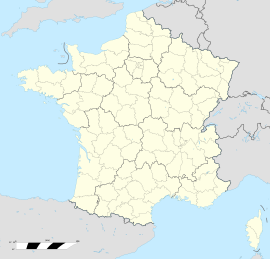Charny, Yonne
| Charny | |
|---|---|
| Coordinates: 47°53′12″N 3°05′49″E / 47.8867°N 3.0969°ECoordinates: 47°53′12″N 3°05′49″E / 47.8867°N 3.0969°E | |
| Country | France |
| Region | Bourgogne-Franche-Comté |
| Department | Yonne |
| Arrondissement | Auxerre |
| Canton | Charny |
| Area1 | 18.99 km2 (7.33 sq mi) |
| Population (2006)2 | 1,716 |
| • Density | 90/km2 (230/sq mi) |
| Time zone | CET (UTC+1) |
| • Summer (DST) | CEST (UTC+2) |
| INSEE/Postal code | 89086 /89120 |
| Elevation | 130–201 m (427–659 ft) |
|
1 French Land Register data, which excludes lakes, ponds, glaciers > 1 km² (0.386 sq mi or 247 acres) and river estuaries. 2Population without double counting: residents of multiple communes (e.g., students and military personnel) only counted once. |
|
1 French Land Register data, which excludes lakes, ponds, glaciers > 1 km² (0.386 sq mi or 247 acres) and river estuaries.
Charny is a former commune in the Yonne department in Bourgogne-Franche-Comté in north-central France. On 1 January 2016, it was merged into the new commune of Charny-Orée-de-Puisaye.
The village lies in the middle of the commune, on the right bank of the river Ouanne, which flows north through the commune.
Charny has been inhabited since the prehistoric period (traces of cut and polished flint have been found in the area). Two historical sites from the Carolingian era still exist : Frécambault and Cocico.
The name of Charny, originally “Caarnetum”, appears on a deed of gift dating from 1130 in the Echarlis Abbey. The moated château of Charny belonged to the Courtenay family and was located close to the church.
The town's heyday would have been during the time of Mahaut d'Artois – the new chatelaine in 1303 (at the time, there were approximately 2000 inhabitants). The lazar house (a place to quarantine people affected by leprosy) and surrounding defensive walls were also constructed during the same period. Mahaut d'Artois embellished the old castle and restored the town. In 1309, King Philippe le Bel was received by Charny.
A second castle, previously known as the “Clos”, used to guard the bridges of the river Ouanne. The watchtower, which still stands today and is called the “Haute Cave”, was built to protect the town in the West.
In 1358 France was invaded by Robert Knowles' troops, but Charny - faithful to the King of France – managed to resist.
However, the town was taken over six times in a row by the Bourguignons and the Armagnacs between 1426 and 1443 – it was completely destroyed and burnt down. After the Hundred Years' War, the town was totally destroyed and remained empty for half a century.
In 1653 a lady known as the “Grande Mademoiselle” (mademoiselle de Montpensier) was exiled in her château at Saint-Fargeau. She donated Charny to her half brother and this explains the presence of a fleur-de-lis on the Charny's coat of arms.
In 1706, a great fire destroyed part of the town – the Grange aux Dîmes (the “Tithe Barn”) and a few houses on the street “rue des Ponts” were all that remained. Towards the end of 1802, Charny became the head town of the canton. In 1840 the bridge over the River Ouanne and the Town Hall were built. In 1946 the small village “la Mothe aux Aulnaies” became a part of Charny – giving it a larger territory over the valley of the River Ouanne.
...
Wikipedia


